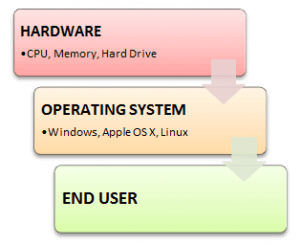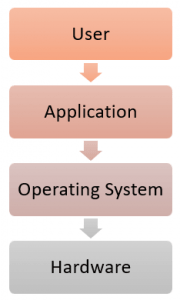An Operating system (OS) is software that functions as an interface between the end user and pc hardware. Every pc must have at least one OS to run other programs. An app on like Chrome, MS Word, Games, etc., needs some environment to run and perform its task.
The OS helps you interact with the computer system without knowing how to speak the computer system’s language. The user can’t utilize any computer or mobile device without having an operating system.
Types Of Operating System & Its Features In 2020
In this article, you can know about Operating System here are the details below;
Models of Operating System with Market Share
Here is a list of Operating Systems with the latest MarketShare
| OS Name | Share |
| Windows | 40.34 |
| Android | 37.95 |
| iOS | 15.44 |
| Mac OS | 4.34 |
| Linux | 0.95 |
| Chrome OS | 0.14 |
| Windows Phone OS | 0.06 |
History Of OS
- – Operating systems were first established in the late 1950s to handle tape storage
- – The General Motors Research Lab implemented the very first OS in the early 1950s for their IBM 701
- – In the mid-1960s, running systems began to use disks
- – In the late 1960s, the very first variation of the Unix OS was developed
- – The first OS constructed by Microsoft was DOS. It was built in 1981 by buying the 86-DOS Software from a Seattle business
- – The present-day popular OS Windows initially pertained to existence in 1985 when a GUI was produced and coupled with MS-DOS.
Features of Operating System
Here is a list of commonly found essential functions of an Operating System:
- – Protected and supervisor mode
- – Allows disk gain access to and file systems Device drivers Networking Security
- – Program Execution
- – Memory management Virtual Memory Multitasking
- – Handling I/O operations
- – Manipulation of the file system
- – Error Detection and handling
- – Resource allotment
- – Information and Resource Protection
What is a Kernel?
The kernel is the main element of a computer system os. The kernel’s only task is to manage the interaction between the software application and the device. A Kernel is at the center of a pc. It makes communication between the Software and hardware possible. While the Kernel is the innermost parts of an operating system, a shell is the outer one.
Features of Kennel
- – Low-level scheduling of procedures
- – Inter-process communication
- – Process synchronization
- – Context changing
Types of Kernels
Many kinds of kernels exist; however, amongst them, the 2 most popular kernels are:
1. Monolithic.
A monolithic kernel is a single codes or block of the program. It offers all the required services provided by the operating system. It is a simplistic design that produces a distinct communication layer between the hardware and Software.
2. Microkernels.
Microkernel handles all system resources. In this type of kernel, services are carried out in various address area. The user services are saved in user address space, and kernel services are kept under kernel address space. So, it assists in decreasing the size of both the kernel and operating system.
Functions of an Operating System.
In an operating system, a software application performs each of the functions.
1. Process management:- Process management helps the OS to develop and erase procedures. It also offers systems for synchronization and interaction amongst approaches.
2. Memory management:- Memory management module carries out allotment and de-allocation of the memory area to programs in need of these resources.
3. File management:- It manages all the files related activities such as organization storage, retrieval, calling, sharing, and defense of files.
4. Device Management: Device management monitors all gadgets. This modules also responsible for this task is referred to as the I/O controller. It likewise carries out the job of allocation and deallocation of the devices.
5. I/O System Managements: One of the primary items of any OS is to conceal the peculiarities of that hardware device from the user.
6. Secondary-Storage Management: Systems have several storage levels, which includes primary storage, secondary storage, and cache storage. Directions and information need to be kept in primary storage or cache so that a running program can reference it.
7. Security:- Security module secures a computer system’s information and information against malware danger and licensed gain access to.
8. Command interpretation: This module translates commands given by the and acting system resources to process those commands.
9. Networking: A distributed systems is a group of processors that do not share a memory, hardwares gadgets, or a clock. The processors communicates with one another through the network.
10. Job accounting: Keeping tracks of time & resources used by numerous job and users.
11. Interaction management: Coordination and assignment of compilers, interpreters, and another software application resource of the various users of the computer system systems.
Kinds of Operating system.
- – Batch Operating System.
- – Multitasking/Time-Sharing OS.
- – Multiprocessing OS.
- – Real-Time OS.
- – Distributed OS.
- – Network OS.
- – Mobile OS.
Batch Operating System.
Some computer system processes are very lengthy and lengthy. To speed the same procedure, a task with a similar kind of needs are batched together and runs as a group.
The users of a batch operating system nevermore directly interacts with the computer. In this type of OS, every users prepares their task on an offline device like a punch cards and gives it to the computer system operator.
Multitasking/Time-sharing Operating systems.
The time-sharing operating system allows individuals located at a different terminal( shell) to use a single computer system simultaneously. The processor time (CPU), which is shared among multiple users, is termed as time-sharing.
Real-time OS.
An actual-time operating system period to process and respond to inputs is minimal. Examples: Military Software Systems, Space Software Systems.
Distributed Operating System.
Distributed systems use numerous processors located in different makers to offer rapid computation to its users.
Network Operating System.
Network Operating System runs on a server. It offers the ability to manage information, user, groups, security, application, and other networking functions.
Mobile OS.
Mobile running systems are those OS that are developed to power smartphones, tablets, and wearables gadgets.
Some most famous mobiles operating systems are Android and iOS; however, others include BlackBerry, Web, and watchOS.
Difference between Firmware and Operating System.
Firmware vs Operating System.
Firmware is one kind of program embedded on a chip in the device that controls that particular gadget. OS supplies functionality over and above that which is provided by the firmware.
Firmware is programs that have been encoded by the manufacture of the IC or something and can not be altered. OS is a program that can be set up by the user and can be changed.
It is stored on non-volatile memory. OS is kept on the hard drives.
Difference among 32-Bit vs. 64 Bit Operating System.
Parameters 32. Bit 64. Bit.
Design and Softwares Allow 32 little bit of information processing simultaneously Allow 64 little bit of information processing all at once.
Compatibility 32-bit applications need 32-bit OS and CPUs. 64-bit applications need a 64-bit OS and CPU.
Systems Available All versions of Window’s 8, Window’s 7, Windows Vista, and Windows XP, Linux, and so on. Window’s XP Professional, Vista, 7, Mac OS X, and Linux.
Memory Limits 32-bit systems are restricted to 3.2 GB of RAM. 64-bit systems allows a maximum of 17 Billion GB of RAM.
The advantage of using an Operating System.
- – Allows you to conceal details of hardware by producing an abstraction.
- – Easy to utilize with a GUI.
- – Offers an environment in which a user might carry out programs/applications.
- – The operating system should make sure that the computer system convenient to utilize.
- – Operating System serves as an intermediary among applications and the hardware parts.
- – It supplies the computer system resources with easy to use format.
- – Acts as an intermediator between all hardware and software of the system.
Disadvantages of using Operating System.
- – If any concern happens in OS, you may lose all the contents which have actually been saved in your system.
- – Operating system Software is quite costly for small size organization which includes concern on them—example Windows.
- – It is never ever completely secure as a risk can take place at any time.
Conclusion:
- – An operating system is a software application that functions as a user interface between completion user and hardware.
- – Operating systems were first established in the late 1950s to manage tape storage.
- – The kernel is the central element of pc operating systems. The only jobs performed by the kernel is to handle the interaction between the software application and the hardware.
- – Two most common kernels are Monolithic and MicroKernels.
- – Process, Device, Files, I/O, Secondary-Storage, Memory management are different functions of an Operating System.
- – Batch, Multitasking/Time-Sharing, Multiprocessing, Real-Time, Distributed, Network, Mobile are various kinds of Operating Systems.







